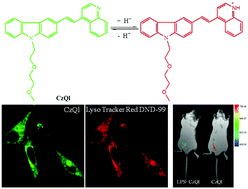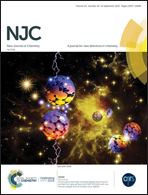Ratiometric emission NIR-fluorescent probe for the detection of lysosomal pH in living cells and in vivo†
Abstract
The lysosome is known to be an acidic organelle that is ubiquitous in cells. Acidic pH is a characteristic feature of lysosomes, and aberrant lysosomal pH values have been manifested to be associated with diverse diseases. In order to monitor the lysosomal pH changes, we developed a ratiometric emission NIR-fluorescent probe (CzQl) for the quantitative analysis of the lysosomal pH in living cells and in vivo. CzQl was constructed via the ethylene bridging of carbazole derivatives and quinoline. The protonation of the probe resulted in a marked green-to-red emission color change. The probe exhibited an ideal pKa value of 4.60 with a linear relationship in the pH range of 3.9–5.3, which covered most of the pH ranges of lysosomes, and was useful for the quantitative detection and imaging of lysosomal pH changes. Moreover, CzQl exhibited easy loading capability, high selectivity, a large Stokes shift, specific lysosome-targeting ability and low cytotoxicity; thereby, it was successfully used for monitoring the lysosomal pH changes at a cellular level as well as the LPS-mediated inflammation in vivo.



 Please wait while we load your content...
Please wait while we load your content...